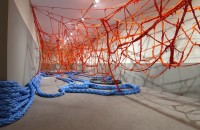SHEILA PEPE
source: brooklynmuseumorg
Born Morristown, NJ, Sheila Pepe lives and works in Brooklyn, NY. Since 1994 Pepe has had numerous solo exhibitions at venues throughout the United States including: Bernard Toale Gallery, Boston; Rowland Contemporary, Chicago; The Santa Barbara Contemporary Arts Forum, CA; Susan Inglett Gallery, New York; Thread Waxing Space, New York; University Gallery at the University of Massachusetts, Amherst; Visual Arts Center, Richmond, VA; Weatherspoon Art Museum, NC; and Zilkha Gallery, Wesleyan University, CT. During that time Pepe has also participated in many group exhibitions, including: Shared Women, (2007) Los Angeles Contemporary Exhibitions; Radical Lace and Subversive Knitting, (2007) Museum of Arts and Design, New York, Decelerate, (2006) at the Kemper Museum, Kansas City; The Photogenic, (2003) ICA, Philadelphia; Greater New York, (2000) P.S.1, New York; Elbowroom Tredja Sparet, Stockholm (1997) and Gothic, (1997) ICA, Boston. Her work is held in a number of private and public collections including: The Jersey City Museum, The Rose Art Museum, and The Harvard University Art Museums. Pepe will make new work for the Smith College Museum of Art in 2008. Education: B.A., Albertus Magnus College, New Haven, CT (1981); B.F.A., Massachusetts College of Art (1983); M.F.A. (1995) School of the Museum of Fine Arts/ Tufts University, Boston; Haystack School, Deer Isle, ME (1984); Skowhegan School of Art (1994). With residences at the Bunting Institute, Radcliffe College at Harvard University (1998/99); and ART OMI, Ghent, NY (1999). Pepe is currently the Assistant Chairperson of Fine Art at Pratt Institute, Brooklyn.
Feminist Artist Statement
Born in 1959, I am one among many feminists who resides in that leaky region between the Baby-Boomers and the Gen X-ers. I came out as a Lesbian Feminist (for a time, Lesbian Separatist) in Boston in 1981, which means I was also among a group of women who were proud to call ourselves Feminists just as it was waning in fashion. Soon after, Feminism was embattled in what I remember as “the Culture Wars,” and I can recall my resistance to the “split,” promising myself to invest in Feminism’s basic promise: to stand as a woman empowered to name all of the disparate parts of her life, and in doing so, take the first step in building bridges toward social justice. Then as now, Feminism is something lived everyday, and as such, lives in my work. In 1979 I was a junior in a small, Catholic, woman’s college. That year I saw Judy Chicago’s The Dinner Party and Eva Hesse’s Hang Up (1966). Chicago’s work was accessible and empowering; Hesse’s was riveting and inexplicable. Twinned, these works have provided the foundation for much of my work, offering models of practice, language, presenting issues of class and audience I now pursue. Around 1995 I understood that my feminism would reside in embracing the women who gave precedent to my work. As other emerging artists tied their practice exclusively to important male artists, it was clear that the historical visibility of women’s work remained contingent on this “old school” sense of solidarity. My experience was affirmed when I finally found Mira Schor’s Patrilineage. Since then I have concentrated on amplifying connections to recognizable Feminist tropes, in an effort to sustain an intergenerational bridge. Along with Hesse and Chicago, these are some among the many women who have provided crucial precedent: Nancy Spero’s strategies of institutional infiltration; Judy Pfaff’s complex conflation of the kinesthetic and visual into an unprecedented “full body” experience; Lynda Benglis’ keen understanding of the bridge between process installation and the decorative object; Kady Van Duers and Diana Davies, with whom I wove my first web during Sonia Johnson’s 1984 presidential campaign; Faith Wilding who set out the original process and imagery of feminist intended crocheted installation; Donna Henes, an important performance/ installation/ weaver of webs in the 1970s; and finally Theresa Nigro, and her daughter, my biological mother, Josephine who taught me how to crochet.


